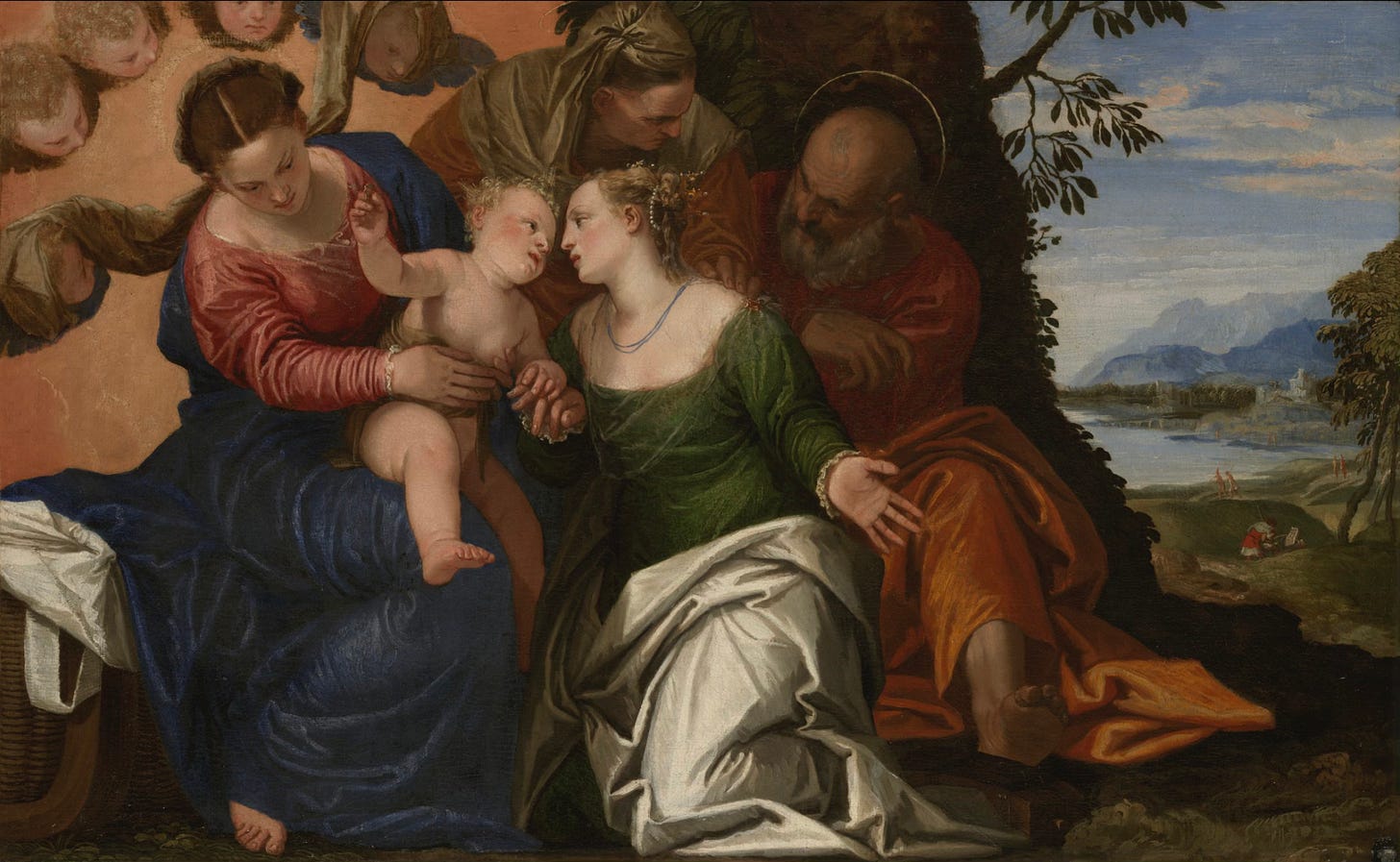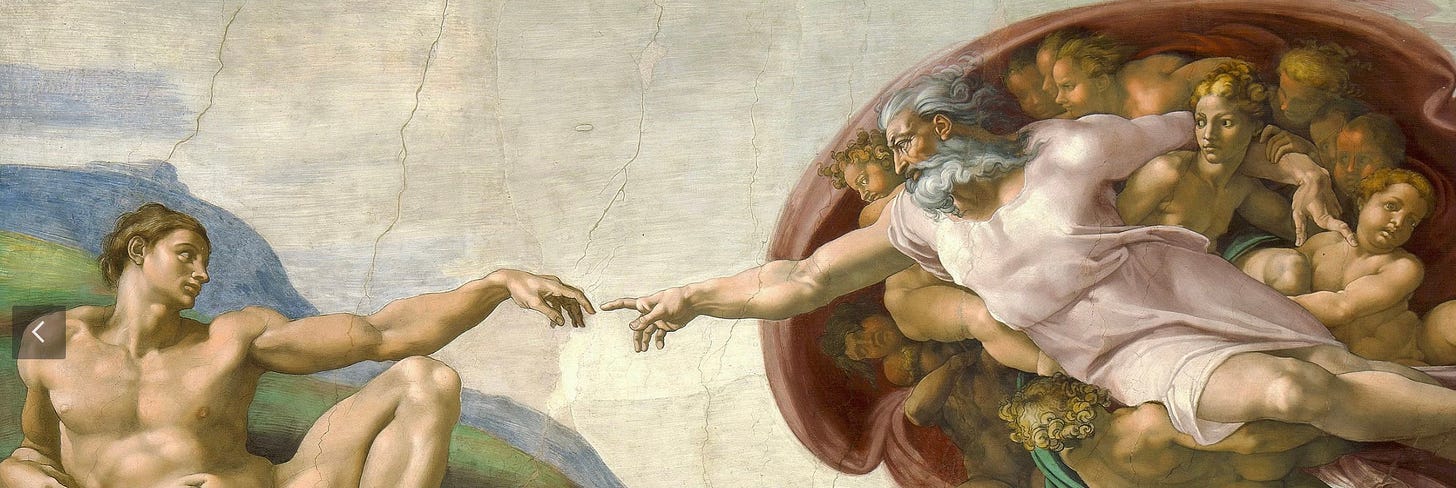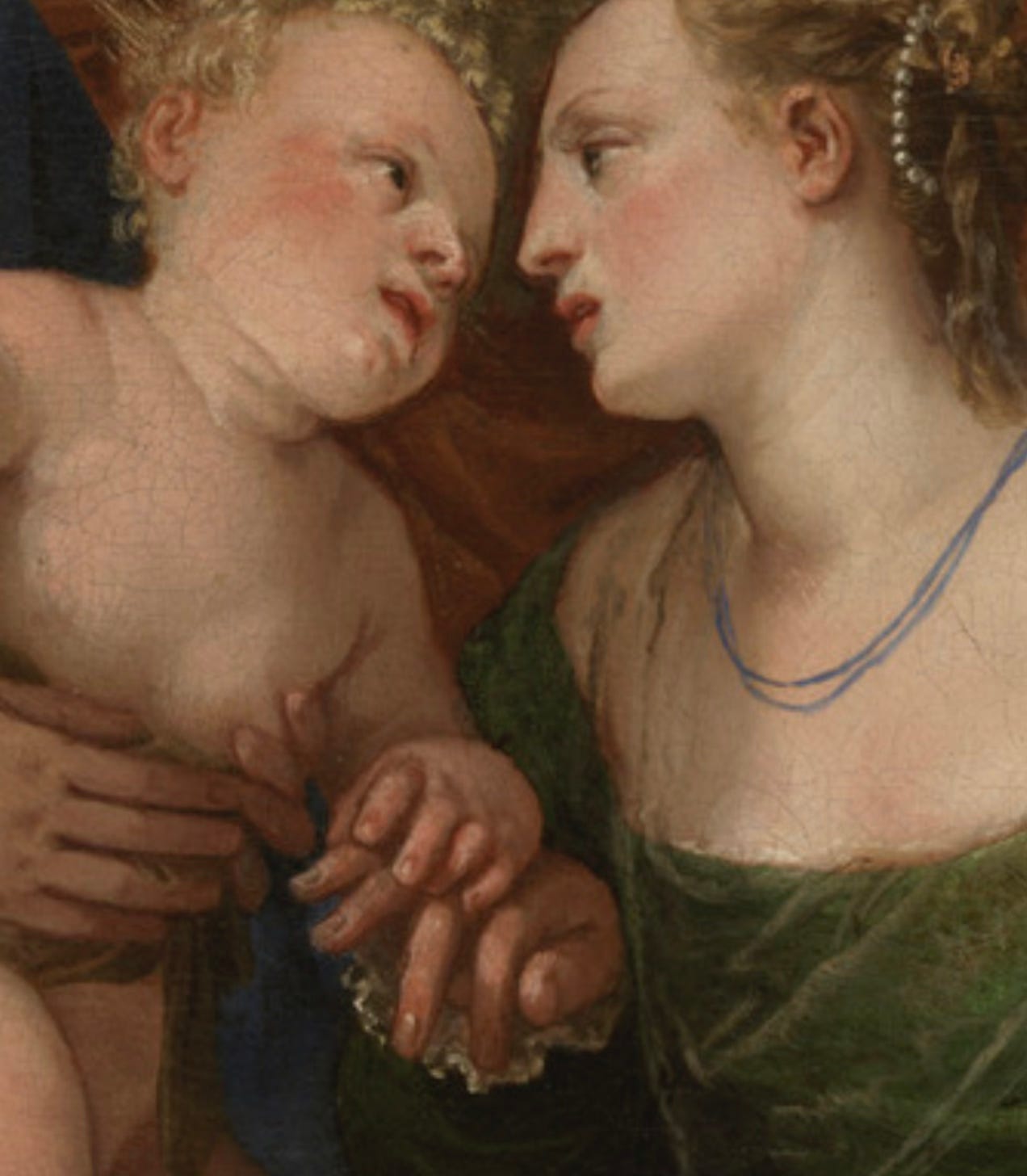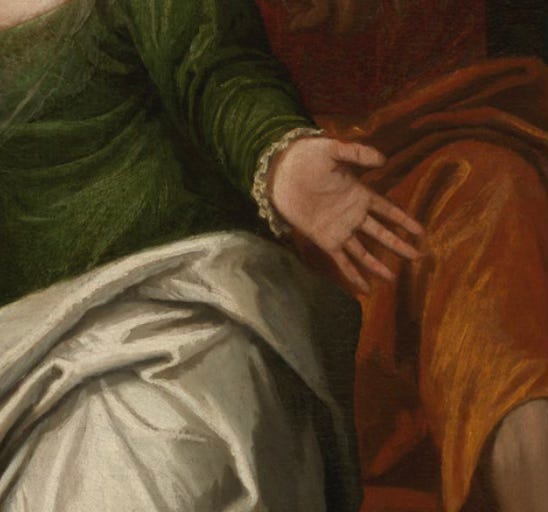Heaven is a Lover's Gaze: Veronese's Mystic Marriage of Saint Catherine
A vivid painting where the eyes connect, with rich velvety fabrics and jewels to warm your winter. Do you see anyone looking at you?

This jewel of a painting richly rewards a close looking. Its juxtapositions of light and shadow, thematic contrasts, and deep, glowing colors make it an absolute pleasure for the eyes. Working in Venice in the mid-16th century, a moment famous for using color as the basis for painting, Veronese might be the Venetian tradition’s most gifted colorist. Look at the Virgin Mary’s rosy red-pink dress and rich dark blue cloak, Saint Catherine’s deep verdant green and Saint Joseph’s velvety orange. The landscape with its rich greens and blues stretches into the distance to the mountains on the painting’s right side, and glowing apricot colors of heavenly light hover behind the Virgin on the left.
The story Veronese painted here, and which I introduced last week (in an updating of the theme by Mary Cassatt), is the vision of Saint Catherine of Alexandria:* Mary holds baby Christ on her lap while he gives Catherine a wedding ring. The visionary, spiritual love becomes physical in this painting (don’t think about it literally or it’s rather creepy) through an intense, interlocking gaze between the baby Christ and Saint Catherine. This moment is as electric as the space between God the Creator and Adam on the Sistine Chapel ceiling, another moment of almost-touching, where the spark of the divine jumps into the world.
There is an absolute, erotic tension between baby Christ’s and Catherine’s faces, as he tilts his forehead toward the line of her profile, as both of their lips part in a lovers’ ecstasy before a kiss…and the entanglement of baby fingers over Catherine’s fingers directly below. It is this center frisson between their eyes, that sustained, unblinking, laser-eyed gaze, from which the rest of the painting’s energy spirals.
How fitting in a painting depicting a vision! Saint Catherine, with apple-bloom complexion and extra-large eyeballs, remains the central figure, as it is her vision, after all. The other adults arch over and semicircle around her. Saint Anne, Christ’s grandmother, bends over Catherine and places four fingers on her back, perhaps helping to gently push her towards Christ. She is placed in shadow, the more to heighten the fair St. Catherine. Anne looks towards St. Joseph, who is sitting behind Catherine in even more shadow at the base of the wide, ivy-climbed tree trunk. The tree helps frame the sacred figures and divides the earth side of the painting from the heaven side. Joseph’s foot comes forward out from under his orange velvet robes and he rests his heel against what turns out to be not a tree root, as I initially expected, but a broken wheel. This is one of the attributes of St. Catherine, who as part of her martyrdom was put on a torturous spiked execution wheel in order to break her, to force her to denounce Christianity—but that didn’t work, since the wheel broke instead.



So Catherine, the mortal saint, kneels and pivots in her vision from the earthly realm on the right to the timeless heavenly realm on the left. We can see the pastoral landscape with its rich greens so appealing to Renaissance viewers in Venice (remember the pastoral ideal was so, so popular in 16th century Venice, as we saw in The Sacrifice of Abraham by Ugo da Carpi after Titian, in the second half of my post dated November 8, 2024)—it might be earthly, but it’s still idealized—and the atmospheric perspective as the mountains become blue and then even lighter blue in the distance. The gentle pink in the striations of the clouds hint at a late afternoon moment, reflected in a lake or a wide river. We can barely make out the people in the rolling background hills, who diminish in size to gently adjust the perspective back into the distant view. These folks tend to carry staves like shepherds or travelers, though I can’t be sure what the middle-distance person is doing—bending over a cart? Reading an inscription at the side of the road carved between the hills? The person seems like a compositional device mostly, wearing red to draw the eye back among the verdant landscape, a way for the viewers to imagine ourselves traveling back along the same meandering route. In the far distance, a few stony buildings reflect partly in the water and merge with the atmospheric hazy blues and greens around it. This is a small painting, and Veronese evokes these details with but single brushstrokes. But the heavy warm atmosphere and the green give it a summery feel, a seasonal moment in earthly time, in a pastoral setting.



In a contrast, Veronese makes the left side of the painting the heavenly realm, with not only a peachy golden background that glows behind Mary, but also with impossible cute cherubim, angelic baby heads with wings, that hover and circle behind Mary, as though doubling her halo and her holiness. Count them—five! One of them is peeking out from under the swath of fabric that the two cherubim on the ends hold up behind her as if she, too, were an angel with wings. Veronese made them each like curious babies, all looking a different direction—the top one maybe looking out to us! Mary emerges from this space, tilting out as she bends to show us the fine central part in her auburn hair. She becomes a link to the earth in a delicate detail of her toes, which stroke the grass on the same ground plane where Catherine kneels. Behind Mary, a large but humble woven laundry basket. What is that doing there? Another link to the earthly? A way for Veronese to continue to show off his excellent command of texture, of fine linens and drapery, and also basketry? He is particularly well known for depicting the material accoutrements and wealth of the aristocracy—he’s so good at pearly sheens, satiny or heavy velvety drapery, the abundance of folds in sleeves, transparent organza and lace emerging at the wrist, strings of pearls in the hair. (When I last lectured on Veronese, I wore a (definitely and sadly, faux) string of pearls in my updo for fun.) A close look shows a mini golden crown with emeralds and pearls nestled into Catherine’s bun, and the ring that Christ holds up has a green bezel-set jewel—how thoughtful of him to match the dress of his betrothed! Remember, Veronese is the master behind the enormous painting Wedding at Cana in the Louvre (mentioned and illustrated in my post dated October 18, 2024) which is full of expensive gowns, fabrics, ceramics, jewelry, exotic imports. Even his atmospheres glow as though bejeweled. This painting of St. Catherine is much, much smaller, but still has a rich depth, and also rich materials, to underscore the holiness of the vision.
Veronese alludes to a third realm, besides the earthly and heavenly on both sides of Catherine in this painting: that of the viewer in front of her. He tilts out the palm of her hand in front of us, as though she presses against the picture plane that divides us from her.
Imagine that we are looking at the painting through a window frame—the picture plane is the surface of the windowpane’s glass, where the fictive painted world begins and where our lived space stops. This idea is a major characteristic in perspectival paintings starting in the Renaissance, described in Leon Battista Alberti’s On Painting in 1435—wherein he laid out the geometry that Brunelleschi and Massaccio and Donatello were already using in their works of both painting and relief sculpture. Alberti called this invisible plane a “veil” hung perpendicularly to the viewer, beyond which a three dimensional box mapped out geometrically in one point perspective. (Apologies for the very quick nutshell version of Alberti! Let me know in the comments if you would like a longer explanation of him and his theories.)
I will definitely return to the idea of the picture plane in the future—it adds whimsy and delight to innumerable paintings. Renaissance artists loved to play with where the picture plane begins, adding shelves, garlands, sills, and little slips of paper, fictive curtains, mirrors, knives that hover, in a trompe l’oeil tease that demonstrate the illusionistic skills of the painter. Here, Veronese has baby Christ kick out his foot, beyond the plane defined by Catherine’s palm. Does that mean he is entering our space, and we, too, can be connected to the divine from our own time-bound realm? Does it unsettle us, not knowing who is closer to us, Catherine or Christ? Are we tempted to reach out and press our own palm against Catherine’s—wait, just kidding! Only in your imagination, please don’t ever actually touch the paintings!



Detail of St. Catherine’s hand; a hand painting from Peche-Merle (see my post on cave paintings, dated September 27, 2024; a classic European road sign.
BONUS COMPARISON:




Holding babies: Which do you prefer, Paolo Veronese or Mary Cassatt?







